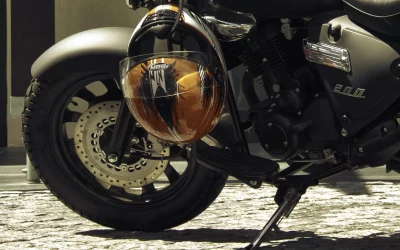BIKERS’ RIGHTS, RULES OF THE ROAD, AND NEGLIGENCE IN MOTORCYCLE ACCIDENTS
Driving Carelessly and Negligently
A biker must complete at least 12 hours in duration to earn a motorcycle license in the state of Colorado. At least 6 hours of real motorcycle operation may be included in authorized motorcycle safety courses.
Furthermore, most motorcycle fans and owners are highly concerned about motorcycle safety and are well-versed in basic and sophisticated motorcycle maintenance and operation. While most motorcyclists are law-abiding people, there are those drivers on the road who operate their cars recklessly, putting motorcyclists in danger of significant physical injury.
The phrases “carelessness” and “negligence” are often interchanged in the practical processing of damage claims and cases. “Careless Driving” is covered by particular legislation. There is no such thing as “negligent driving” legislation. The phrase is most often used in the context of civil law.
Free Consultation
In Person | Phone | Zoom
Colorado Statutes – Driving Dangerously
Any individual driving a car on the state’s streets or roads must do so with care and caution, taking into account the width, grade, curves, corners, traffic, and any other relevant factors to not harm the life, limb or property of others. Careless driving and a violation of this section will result if you do not drive in this way.
This legislation is especially relevant in the case of motorcycle accidents. The motorcyclist is in danger of harm to life, limb, and property if he or she is struck by another car or forced to make an evasive move. Motorcyclists lack the same crashworthiness safeguards as passengers in most passenger cars.
When driving a motor car, drivers should use caution. This is not just plain sense, but it is also expressly stated in the Colorado Statutes. A driver of a motor car can be careless in a variety of ways, including rear-ending another car, changing lanes when it is unsafe to do so, violating or disobeying street signage and signals, exceeding speed limits, passing in a no-pass zone, passing when it is unsafe to do so, and making a left hand turn into a motorcyclist’s right of way.
It’s worth noting that under Colorado law, reckless driving does not have to be a deliberate, hateful, or intended behavior. A police officer might issue a “careless driving” penalty to a car that smashes into a stopped motorcycle as he or she approaches a red light because he or she was distracted for a time by a flashing billboard.
If the motorcyclist is harmed, he or she may file a civil lawsuit or file an insurance claim against the at-fault motorist for carelessness. While careless driving and negligent driving are comparable, the
words “reckless driving” and the conduct of “reckless driving” are quite different. Reckless Driving Injures Motorcyclists, for example.
There are usually a lot of concerns, problems, and issues for the wounded biker and his or her family following a motorcycle accident caused by reckless or irresponsible driving. There is much more to the case or allegation than the other motorist receiving a traffic penalty.
Insurance firms are well-equipped and staffed to defend a claim or lawsuit to protect themselves and their insureds. Investigators, in-office claims adjusters, fi adjusters, bodily injury adjusters, property damage adjusters, medical bill processors, medical bill auditors, and others are hired and employed by insurance companies, forming a strong army to contest numerous cases and claims.
In the aftermath of a motorcycle accident, the wounded rider and his or her family should have an advocate to safeguard and defend their legal rights. A Colorado Motorcycle Accident Attorney can assist the injured party in levelling the playing field with the insurance providers.
Careless and Negligent Driving Examples
Suppose a person is harmed due to a Colorado motorcycle accident. In that case, a lawsuit or claim for damages and compensation may be filed if the accident was caused by the truck driver’s fault, negligence, or carelessness. There is a statute in Colorado that explicitly handles this situation. (1) Any person operating a car on the streets or highways within the state shall drive it carefully and prudently, having regard for the width, grade, curves, corners, traffic, and all other attendant circumstances, so as not to endanger the life, limb, or property of any person, according to Section 316.1925, Colorado Statutes. Careless driving and a violation of this section will result if you do not drive in this way.
Drivers in Colorado must follow all traffic laws and regulations, including but not limited to those concerning speed limits, traffic signals, stop signs, school zones, residential areas, and highway driving. Distracted driving, which includes cell phone use, computer surfing, e-mailing, and texting, is a big issue in Colorado.
Whether it’s a quick drive to the grocery store or a longer journey on Interstate 95, Interstate 10, or any other Colorado highway, there are a variety of conditions that might result in a car accident.
Each motorcycle accident should be assessed based on its unique facts, circumstances, and merits. Suppose it can be shown that another motorist was at fault or otherwise accountable for the accident. In that case, a civil lawsuit or claim may be filed on behalf of the personal injury victim.
- The driver disregards a stop sign.
- The driver makes an incorrect or unsafe left-hand turn, obstructing the biker’s right of way.
- A car driver goes beyond the speed limit and collides with a motorcycle.
- The driver fails to pay attention to the road and weather conditions and loses control of his or her
- car.
- A motorcycle gets rear-ended by a car that has stopped or slowed down for traffic.
- The driver does an erroneous or unlawful U-turn.
- On a wet or sloppy road, a driver hydroplanes and collides with a motorcycle.
- The driver fails to come to a complete stop at a stop sign.
- At a marked yield sign, the driver fails to surrender the right of way.
- A driver fails to give a cyclist the right of way.
- A drugged or drunk driver collides with a motorcycle.
The following list does not include all possible causes of a Colorado motorcycle accident that might result in a legal lawsuit or claim being filed on behalf of an injured victim. Each case or claim, like each client, is unique and must be assessed based on its facts, merits, and circumstances.
When another driver’s negligence, carelessness, or fault causes an accident, the injury victim should seek compensation for his or her injuries to the maximum degree possible under Colorado law, depending on the merits of the claim or case.
Violations of the Right of Way
A motorcyclist in Colorado has the right to seek damages/compensation for bodily injuries sustained due to another driver’s negligence, carelessness, or recklessness. A breach of the motorcyclist’s right of way causes many motorcycle accidents.
“Watch Out for Motorcycles” and “Look Twice for Motorcycles” should be the mantras of other drivers. Unfortunately, many drivers fail to recognize or watch motorcycles on the roads, streets, and highways. The infringement of the motorcyclist’s right of way causes many motorcycle accidents.
An erroneous or unsafe left hand turn into the path of a motorcycle is a regular right of way infringement. Section 316.122 of the Colorado Statutes – Car Making a Left Turn:
Any car approaching from the opposite direction, or cars lawfully passing on the left of the turning car, which is within the intersection or so close to it as to constitute an immediate hazard, shall yield the right-of-way to any car approaching from the opposite direction, or cars lawfully passing on the left of the turning car. A breach of this section is a noncriminal traffic offence that is penalized under Chapter 318 as a moving violation.
As a result, a motorist trying to turn left must cede the right of way to a motorcycle travelling straight down the road. The negligent driver’s infringement of the motorcyclist’s right of way arises for several causes, including but not limited to speed, inattention, and distraction.
Even if the cars (motorcycle and car) do not crash, many such breaches of the biker’s right of way result in injury to the rider. Even if a motorcyclist makes evasive efforts to avoid a collision with a car, they may still get bodily harm if they have to lay down the bike or collide with another object or obstruction.
A car changing lanes into the right of way or route of travel of a motorcycle is another typical right of way infringement. Limitations on Overtaking, Passing, Changing Lanes, and Changing Course (Section
316.085 (2), Colorado Statutes): No car shall be driven from a direct course in any lane on any highway until the driver has determined that the car is not being approached or passed by any other car in the lane or on the side to which the driver desires to move and that the move can be made completely safe and without interfering with the safe operation of any other car.
Drivers often fail to see or observe motorcyclists on the road until it is too late. Motorcyclists should be given the right of way, and drivers should be aware of their presence on the roads. Many lane changes or violations of the right of way accidents involving motorcyclists may be avoided if drivers decrease their speeds and focus on the main job at hand (driving).
A right-of-way motorcycle collision may cause significant bodily injury to both the motorcycle rider and the passenger. Following a motorcycle accident, the wounded biker has a variety of obstacles, including medical costs, emergency medical care, and follow-up medical treatment, to name a few.
Insurance companies often contest the extent of injuries sustained in a motorcycle accident. Furthermore, compensation for personal injuries sustained in a motorcycle accident takes time to complete. It’s critical that the personal injuries are thoroughly recorded and that the claim and case be presented to the insurance company correctly.
Let’s be honest. Insurance adjusters are employed by insurance companies and are fiercely loyal to them. An advocate in the shape of a Colorado Motorcycle Accident Attorney is critical for a motorcycle accident victim and his or her family.
Left-Hand Turns Done Carelessly
A sloppy or reckless left-hand turn is a frequent cause of Colorado motorcycle accidents. For several years, there has been a campaign with the basic message, “Look Twice for Motorcycles.” This straightforward tip is particularly useful when making a left-hand turn in a car. When making a left-hand turn at a two-way junction, the individual making the turn should make sure it is safe and clear to do so. For a person wishing to make a left-hand turn, the speed, distance, and safety of incoming cars should not be concerned. If the driver has any concerns about the turn’s safety or timeliness, he or she should wait for approaching traffic to clear before trying the left-hand turn.
The following Colorado law applies to left-hand turns at junctions, according to Section 316.151 of the Colorado Statutes:
316.151 At junctions, the required location and technique of turning are required.–
A motorist wanting to turn at an intersection must do so in the following manner:
(b) Make a left turn.–
The driver of a car intending to turn left at an intersection must approach the intersection in the farthest left-hand lane lawfully available to traffic moving in the same direction as the car, and the left turn must be made after entering the intersection in a lane lawfully available to traffic moving in the same direction as the car. When possible, the left turn should be done in the junction area to the left of the intersection’s center.
It’s worth noting that front-end collisions, rather than rear-end collisions, account for most motorcycle accidents in Colorado. Motorists often fail to detect motorcyclists coming from the other way due to most motorcycles’ size, height, and breadth.
Furthermore, there is a widespread issue with motorists who speed, are distracted, or otherwise drive their cars carelessly and negligently.
Although there is no contact between the turning car and the rider in some motorcycle collisions, the motorcycle nonetheless crashes owing to evasive maneuvers by the biker who tried all he or she could to avoid colliding with the careless turning car. As a result, a news story of a single-car (motorcycle) accident might be deceptive at times.
It is useful if the other motorist is given a traffic ticket while pursuing a claim or case for personal injuries in Colorado; nevertheless, it should be emphasized that the issuance or absence of a traffic citation is not a controlling fact on the civil case for personal injuries.
In other words, the investigating police officer, who most likely did not witness the actual collision, does not have any influence over the civil case’s outcome. In reality, in most cases, issuing a ticket is not admissible in evidence at trial.
Oncoming traffic is effectively given the right of way under Colorado above Statute. When attempting a left-hand turn in Colorado (or other states), the motorist must be cautious. It is a legal requirement to yield to oncoming cars. Failure to yield may result in catastrophic results for motorcyclists, including personal injury and even wrongful death.
Lane Changes That Aren’t Proper.
Motorcycle riders have the right, freedom, and liberty to ride on public streets, highways, interstates, and expressways. Other drivers must keep an eye out for motorcycles and respect their rights. Unfortunately, far too many drivers of motor cars are distracted, in a hurry, or just reckless when driving. Consequently, car/motorcycle collisions occur that might have been prevented with greater attention, slower speeds, and a thorough understanding of traffic and the proper location of bikes on the highways.
Limitations on Overtaking, Passing, Changing Lanes, and Changing Course, Section 316.085, Colorado Statutes, lays forth the following rules for changing lanes in Colorado:
No car shall be driven in any lane on any highway from a direct course until the driver has determined that the car is not being approached or passed by any other car in the lane or on the side to which the driver wishes to move and that the move can be made safely and without interfering with the safe operation of any car approaching from the same direction.







